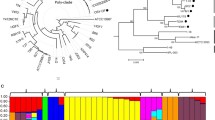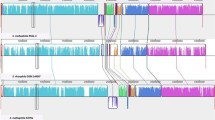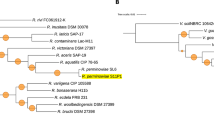Abstract
The Xanthomonadaceae family comprises the genera Xanthomonas and Xylella, which include plant pathogenic species that affect economically important crops. The family also includes the plant growth-promoting bacteria Pseudomonas geniculata and Stenotrophomonas rhizophila, and some other species with biotechnological, medical, and environmental relevance. Previous work identified molecular signatures that helped to understand the evolutionary placement of this family within gamma-proteobacteria. In the present study, we investigated whether insertions identified in highly conserved proteins may also be used as molecular markers for taxonomic classification and identification of members within the Xanthomonadaceae family. Four housekeeping proteins (DNA repair and replication-related and protein translation enzymes) were selected. The insertions allowed discriminating phytopathogenic and plant growth-promoting groups within this family, and also amino acid sequences of these insertions allowed distinguishing different genera and, eventually, species as well as pathovars. Moreover, insertions in the proteins MutS and DNA polymerase III (subunit alpha) are conserved in Xylella fastidiosa, but signatures in DNA ligase NAD-dependent and Valyl tRNA synthetase distinguish particular subspecies within the genus. The genus Stenotrophomonas and Pseudomonas geniculata could be distinguishable based on the insertions in MutS, DNA polymerase III (subunit alpha), and Valyl tRNA synthetase, although insertion in DNA ligase NAD-dependent discriminates these bacteria at the species level. All these insertions differentiate species and pathovars within Xanthomonas. Thus, the insertions presented support evolutionary demarcation within Xanthomonadaceae and provide tools for the fast identification in the field of these bacteria with agricultural, environmental, and economic relevance.






Similar content being viewed by others
References
Saddler GS, Bradbury J (2005) Xanthomonadales ord. In: Brenner DJ, Krieg NR, Staley JT (eds) Bergey’s manual® of systematic bacteriology, Vol. 2, 2nd. Springer, New York, pp 63. https://doi.org/10.1007/0-387-28022-7_3,
Cutiño-Jimenez AM, Martins-Pinheiro M, Lima WC, Martin-Tornet A, Morales O, Martins Menck CF (2010) Evolutionary placement of Xanthomonadales based on conserved protein signature sequences. Mol Phylogenet Evol 54:524–534. https://doi.org/10.1016/j.ympev.2009.09.026
Naushad S, Adeolu M, Wong S, Sohail M, Schellhorn HE, Gupta RS (2015) A phylogenomic and molecular marker based taxonomic framework for the order Xanthomonadales: proposal to transfer the families Algiphilaceae and Solimonadaceae to the order Nevskiales ord. nov. and to create a new family within the order Xanthomonadales, the family Rhodanobacteraceae fam. nov., containing the genus Rhodanobacter and its closest relatives. Antonie Van Leeuwenhoek 107(2):467–485. https://doi.org/10.1007/s10482-014-0344-8
Parte AC (2018) LPSN-list of prokaryotic names with standing in nomenclature (bacterio.net), 20 years on. Int J Syst Evol Microbiol 68(6):1825–1829. https://doi.org/10.1099/ijsem.0.002786
Zhou L, Huang TW, Wang JY, Sun S, Chen G, Poplawsky A, He YW (2013) The Rice bacterial pathogen Xanthomonas oryzae pv. oryzae produces 3-Hydroxybenzoic acid and 4-Hydroxybenzoic acid via XanB2 for use in Xanthomonadin, ubiquinone, and exopolysaccharide biosynthesis. Mol Plant-Microbe Interact 26:1239–1248. https://doi.org/10.1094/MPMI-04-13-0112-R
da Silva AR, Ferro JA, Reinach F, Farah C, Furlan L, Quaggio R et al (2002) Comparison of the genomes of two Xanthomonas pathogens with differing host specificities. Nature 417:459–463. https://doi.org/10.1038/417459a
Palmieri ACB, Amaral AMD, Homem RA, Machado MA (2010) Differential expression of pathogenicity- and virulence-related genes of Xanthomonas axonopodis pv. citri under copper stress. Genet Mol Biol 33:348–353. https://doi.org/10.1590/S1415-47572010005000030
Giovanardi D, Biondi E, Ignjatov M, Jevtić R, Stefani E (2018) Impact of bacterial spot outbreaks on the phytosanitary quality of tomato and pepper seeds. Plant Pathol 67(5):1168–1176. https://doi.org/10.1111/ppa.12839
European and Mediterranean Plant Protection Organization (2016) Data sheets on pests recommended for regulation. Xanthomonas axonopodis pv. allii. Bull OEPP/EPPO 46(1):4–7. https://doi.org/10.1111/epp.12273
Pieretti I, Cociancich S, Bolot S, Carrère S, Morisset A, Rott P, Royer M (2015) Full genome sequence analysis of two isolates reveals a novel Xanthomonas species close to the sugarcane pathogen Xanthomonas albilineans. Genes 6(3):714–733. https://doi.org/10.3390/genes6030714
Constantin EC, Haegeman A, Van-Vaerenbergh J, Baeyen S, Van-Malderghe C et al (2017) Pathogenicity and virulence gene content of Xanthomonas strains infecting Araceae, formerly known as Xanthomonas axonopodis pv. dieffenbachiae. Plant Pathol 66:1539–1554. https://doi.org/10.1111/ppa.12694
Su CC, Chang CJ, Chang CM, Shih HT, Tzeng KC, Jan FJ, Kao CW, Deng WL (2013) Pierce’s disease of grapevines in Taiwan: isolation, cultivation and pathogenicity of Xylella fastidiosa. J Phytopathol 161:389–396. https://doi.org/10.1111/jph.12075
Niza B, Coletta-Filho H, Merfa MV, Takita MA, De Souza AA (2015) Differential colonization patterns of Xylella fastidiosa infecting citrus genotypes. Plant Pathol 64(6):1259–1269. https://doi.org/10.1111/ppa.12381
Almeida RPP, Nunney L (2015) How do plant diseases caused by Xylella fastidiosa emerge? Plant Dis 99:1457–1467. https://doi.org/10.1094/PDIS-02-15-0159-FE
Amanifar N, Taghavi M, Izadpanah K, Babaei G (2014) Isolation and pathogenicity of Xylella fastidiosa from grapevine and almond in Iran. Phytopathol Mediterr 53:318–327. https://doi.org/10.14601/Phytopathol_Mediterr-12647
Puopolo G, Giovannini O, Pertot I (2014) Lysobacter capsici AZ78 can be combined with copper to effectively control Plasmopara viticola on grapevine. Microbiol Res 169:633–642. https://doi.org/10.1016/j.micres.2013.09.013
Olson JD, Damicone JP, Kahn BA (2016) Identification and characterization of isolates of Pythium and Phytophthora spp. from snap beans with cottony leak. Plant Dis 100:1446–1453. https://doi.org/10.1094/PDIS-06-15-0662-RE
Hernández I, Fernández C (2017) Draft genome sequence and assembly of a Lysobacter enzymogenes strain with biological control activity against root knot nematodes. Genome Announc 5:e00271–e00217. https://doi.org/10.1128/genomeA.00214-17
Sánchez MB (2015) Antibiotic resistance in the opportunistic pathogen Stenotrophomonas maltophilia. Front Microbiol 6:658. https://doi.org/10.3389/fmicb.2015.00658
Aydi AR, Jabnoun-Khiareddine H, Nefzi A, Daami-Remadi M (2018) Evaluation of the growth-promoting potential of endophytic bacteria recovered from healthy tomato plants. J Hortic 05:5(2). https://doi.org/10.4172/2376-0354.1000234
Sharma P, Sharma N (2018) Molecular identification, production and optimization of pectinase by using Stenotrophomonas maltophilia P9 isolated from algal biomass of Himachal Pradesh, India. Int J Curr Microbiol App Sci 7(1):670–680. https://doi.org/10.20546/ijcmas.2018.701.082
Nayak AS, Vijaykumar MH, Karegoudar TB (2009) Characterization of biosurfactant produced by Pseudoxanthomonas sp. PNK-04 and its application in bioremediation. Int Biodeterior Biodegradation 63:73–79. https://doi.org/10.1016/j.ibiod.2008.07.003
Gupta RS (2014) Identification of conserved indels that are useful for classification and evolutionary studies. In: Goodfellow M, Sutcliffe L, Jongsik C (eds) Methods in microbiology, vol 41. Academic Press, New York, pp 153–182. https://doi.org/10.1016/bs.mim.2014.05.003
Gupta R (2016) Impact of genomics on the understanding of microbial evolution and classification: the importance of Darwin’s views on classification. FEMS Microbiol Rev 40:520–553. https://doi.org/10.1093/femsre/fuw011
Kriventseva EV, Tegenfeldt F, Petty TJ, Waterhouse RM, Simao FA, Pozdnyakov IA, Zdobnov EM (2015) OrthoDB v8: update of the hierarchical catalog of orthologs and the underlying free software. Nucleic Acids Res 43(D1):D250–D256. https://doi.org/10.1093/nar/gku1220
UniProt Consortium (2019) UniProt: a worldwide hub of protein knowledge. Nucleic Acids Res 47:D506–D515. https://doi.org/10.1093/nar/gky1049
Altschul SF, Madden TL, Schaffer AA, Zhang J, Zhang Z et al (1997) Gapped BLAST and PSI-BLAST: a new generation of protein database search programs. Nucleic Acids Res 25:3389–3402. https://doi.org/10.1093/nar/25.17.3389
Pearson WR (2013) An introduction to sequence similarity (“homology”) searching. Curr Protoc Bioinformatics 42(1):3–1. https://doi.org/10.1002/0471250953.bi0301s42
Thompson JD, Gibson TJ, Plewniak F, Jeanmougin F, Higgins D (1997) The CLUSTAL_X windows interface: flexible strategies for multiple sequence alignment aided by quality analysis tools. Nucleic Acids Res 25(24):4876–4882. https://doi.org/10.1093/nar/25.24.4876
Hall BG (2005) Comparison of the accuracies of several phylogenetic methods using protein and DNA sequences. Mol Biol Evol 22(3):792–802. https://doi.org/10.1093/molbev/msi066
Khadka B, Persaud D, Gupta RS (2020) Novel sequence feature of SecA translocase protein unique to the thermophilic bacteria: bioinformatics analyses to investigate their potential roles. Microorganisms 8(1):59. https://doi.org/10.3390/microorganisms8010059
Lanfear R, Calcott B, Ho SYW, Guindon S (2012) PartitionFinder: combined selection of partitioning schemes and substitution models for phylogenetic analyses. Mol Biol Evol 29:1695–1701. https://doi.org/10.1093/molbev/mss020
Stamatakis A (2014) RAxML version 8: a tool for phylogenetic analysis and post-analysis of large phylogenies. Bioinformatics 30(9):1312–1313. https://doi.org/10.1093/bioinformatics/btu033
Ronquist F, Teslenko M, Van-Der-Mark P, Ayres DL, Darling A et al (2012) MrBayes 3.2: efficient Bayesian phylogenetic inference and model choice across a large model space. Syst Biol 61(3):539–542. https://doi.org/10.1093/sysbio/sys029
Pattengale ND, Alipour M, Bininda-Emonds ORP, Moret BME, Stamatakis A (2010) How many bootstrap replicates are necessary. J Comput Biol 17:337–354. https://doi.org/10.1089/cmb.2009.0179
Rambaut A, Drummond AJ, Xie D, Baele G, Suchard MA (2018) Posterior summarization in bayesian phylogenetics using tracer 1.7. Syst Biol 67(5):901–904. https://doi.org/10.1093/sysbio/syy032
Naushad HS, Gupta RS (2013) Phylogenomics and molecular signatures for species from the plant pathogen-containing order Xanthomonadales. PLoS One 8:e55216. https://doi.org/10.1371/journal.pone.0055216
Gupta RS, Naushad S, Baker S (2015) Phylogenomic analyses and molecular signatures for the class Halobacteria and its two major clades: a proposal for division of the class Halobacteria into an emended order Halobacteriales and two new orders, Haloferacales ord. nov. and Natrialbales ord. nov., containing the novel families Haloferacaceae fam. nov. and Natrialbaceae fam. nov. Int J Syst Evol Microbiol 65:1050–1069. https://doi.org/10.1099/ijs.0.070136-0
Ho J, Adeolu M, Khadka B, Gupta RS (2016) Identification of distinctive molecular traits that are characteristic of the phylum “Deinococcus-Thermus” and distinguish its main constituent groups. Syst Appl Microbiol 39:453–463. https://doi.org/10.1016/j.syapm.2016.07.003
Harper SJ, Ward LI, Clover GRG (2010) Development of LAMP and real-time PCR methods for the rapid detection of Xylella fastidiosa for quarantine and field applications. Phytopathology 100(12):1282–1288. https://doi.org/10.1094/PHYTO-06-10-0168
Roach R, Mann R, Gambley CG (2018) Identification of Xanthomonas species associated with bacterial leaf spot of tomato, capsicum and chilli crops in eastern Australia. Eur J Plant Pathol 150:595–608. https://doi.org/10.1007/s10658-017-1303-9
Anzai Y, Kim H, Park JY, Wakabayashi H, Oyaizu H (2000) Phylogenetic affiliation of the pseudomonads based on 16S rRNA sequence. Int J Syst Evol Microbiol 50(4):1563–1589. https://doi.org/10.1099/00207713-50-4-1563
Gopalakrishnan S, Srinivas V, Prakash B, Sathya A, Vijayabharathi R (2015) Plant growth-promoting traits of Pseudomonas geniculata isolated from chickpea nodules. 3 Biotech 5:653–661. https://doi.org/10.1007/s13205-014-0263-4
Schmidt CS, Alavi M, Cardinale M, Müller H, Berg G (2012) Stenotrophomonas rhizophila DSM14405T promotes plant growth probably by altering fungal communities in the rhizosphere. Biol Fertil Soils 48:947–960. https://doi.org/10.1007/s00374-012-0688-z
Funding
The work of CFMM is supported by FAPESP (Fundação de Amparo à Pesquisa do Estado de São Paulo, Grant no. 2019/19435-3), CAPES (Coordenação de Aperfeiçoamento de Pessoal de Ensino Superior, Funding Code 001), and CNPq (Conselho Nacional de Desenvolvimento Científico e Tecnológico, Grant no. 308868/2018-8), Brazil.
Author information
Authors and Affiliations
Corresponding author
Ethics declarations
Conflict of interest
The authors declare that they have no conflict of interest.
Additional information
Responsible Editor: Derlene Attili Agellis
Publisher’s note
Springer Nature remains neutral with regard to jurisdictional claims in published maps and institutional affiliations.
Rights and permissions
About this article
Cite this article
Cutiño-Jiménez, A.M., Menck, C.F.M., Cambas, Y.T. et al. Protein signatures to identify the different genera within the Xanthomonadaceae family. Braz J Microbiol 51, 1515–1526 (2020). https://doi.org/10.1007/s42770-020-00304-2
Received:
Accepted:
Published:
Issue Date:
DOI: https://doi.org/10.1007/s42770-020-00304-2




